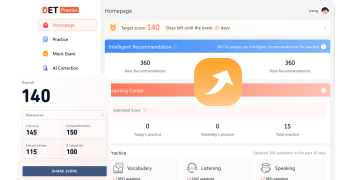Dominar la sección "Leer, Luego Hablar" del examen de inglés de Duolingo
El Duolingo English Test es una forma conveniente y económica de evaluar tu dominio del inglés en línea. A diferencia de otras pruebas estandarizadas, el Duolingo English Test tiene un formato único que se adapta a tu nivel y habilidades. Una de las partes más desafiantes e importantes de la prueba es la sección “Read, Then Speak”, en la que debes hablar sobre un tema durante 90 segundos después de leer una instrucción.
En este artículo, te mostraremos cómo dominar esta sección y mejorar tus subpuntuaciones de Conversación y Producción.
Cubriremos:
- Entendiendo el Formato de “Read, Then Speak”
- Preparándote para Responder
- Estructurando tu Respuesta
- Entregando tu Respuesta
- Mejorando tu Respuesta
- Incorporando una Pregunta de Muestra y una Respuesta de Demostración
- Consejos de Práctica y Recursos

Entendiendo el Formato de “Read, Then Speak”
La sección “Read, Then Speak” es uno de los cuatro tipos de tareas de habla en el Duolingo English Test. Te pide que “Hables sobre el tema a continuación durante 90 segundos.”
Para este tipo de pregunta, verás una instrucción escrita en la pantalla. Tendrás 20 segundos para leer la instrucción y preparar tu respuesta. Luego, la prueba avanzará automáticamente a la pantalla de grabación, donde tendrás 90 segundos para hablar tu respuesta. Aún podrás ver la instrucción mientras hablas.
La instrucción generalmente te pedirá que hables sobre una experiencia personal, opinión o preferencia. Por ejemplo:
- Habla sobre tu restaurante favorito.
- Habla sobre una vez en que tuviste que tomar una decisión difícil.
- Describe un pasatiempo que disfrutas.
La instrucción también incluirá algunos puntos clave para guiar tu respuesta. Por ejemplo:
- ¿Dónde está?
- ¿Qué tipo de comida sirve?
- ¿Con qué frecuencia vas allí?
- ¿Por qué es tu favorito?
Tu respuesta será calificada en base a dos subpuntuaciones: Conversación y Producción. La Conversación mide qué tan bien interactúas con la pregunta y expresas tus ideas. La Producción mide qué tan bien usas el vocabulario y la gramática para comunicarte clara y precisamente.
Preparándote para Responder
La clave para una respuesta exitosa es entender rápidamente la instrucción y organizar tus pensamientos en un corto período de tiempo. Aquí hay algunas estrategias para ayudarte a prepararte:
- Lee la instrucción cuidadosamente e identifica el tema principal y los subtemas. Por ejemplo, si la instrucción es “Habla sobre tu restaurante favorito.”, el tema principal es tu restaurante favorito, y los subtemas son dónde está, qué tipo de comida sirve, con qué frecuencia vas allí, y por qué es tu favorito.
- Piensa en un ejemplo específico relacionado con el tema principal. Por ejemplo, si tu restaurante favorito es un lugar tailandés cerca de tu casa, piensa en un momento memorable cuando fuiste allí con tus amigos o familia.
- Usa los puntos clave como guía para estructurar tu respuesta. Por ejemplo, puedes empezar presentando tu restaurante favorito, luego hablar sobre cada punto clave en orden, y terminar con una conclusión que resuma tu idea principal.
- Usa efectivamente los 20 segundos de tiempo de preparación. Puedes encontrar algunas palabras clave para ayudarte a recordar tus puntos principales. También puedes practicar diciendo la primera oración de tu respuesta para comenzar con confianza.
Estructurando tu Respuesta
Una estructura clara y lógica de respuesta te ayudará a entregar tu respuesta de manera fluida y coherente. Aquí hay algunos consejos para ayudarte a estructurar tu respuesta:
- Crea una introducción, un cuerpo y una conclusión. Tu introducción debería presentar brevemente el tema principal y declarar tu punto principal. Tu cuerpo debería desarrollar tu punto principal hablando sobre cada subtema en detalle. Tu conclusión debería resumir tu punto principal y terminar con un comentario final.
- Usa palabras y frases de transición para conectar tus ideas y oraciones. Por ejemplo, puedes usar palabras como “first”, “second”, “third”, “next”, “then”, “finally”, “also”, “however”, “for example”, “in conclusion”, etc.
- Aborda todas las partes de la instrucción. Asegúrate de no omitir ni ignorar ningún punto clave. Si no tienes nada que decir sobre un subtema, puedes reconocerlo brevemente y seguir adelante. Por ejemplo, puedes decir “I don’t go there very often, but when I do, I always enjoy it.”
- Mantente enfocado en el tema. No te desvíes ni añadas detalles irrelevantes. Si te encuentras alejándote del tema, vuelve al punto principal y a los puntos clave.
Entregando tu Respuesta
Tu entrega es tan importante como tu contenido. Aquí hay algunas técnicas para ayudarte a entregar tu respuesta clara y fluidamente:
- Habla de forma natural y clara. Usa una velocidad y un volumen normales al hablar. No hables demasiado rápido ni demasiado lento, demasiado alto ni demasiado bajo. Pronuncia tus palabras correctamente y evita murmurar o arrastrar las palabras.
- Usa palabras y estructuras variadas. No repitas las mismas palabras o frases una y otra vez. Usa sinónimos, antónimos o paráfrasis para expresar la misma idea de diferentes maneras. Usa un rango de vocabulario y estructuras gramaticales para mostrar tu dominio y precisión.
- Gestiona bien tu tiempo. Tienes 90 segundos para dar tu respuesta, lo cual es suficiente para cubrir la instrucción y los puntos clave. No hables demasiado tiempo ni muy poco. Si terminas tu respuesta antes de que se acabe el tiempo, puedes añadir algunos detalles o ejemplos adicionales para elaborar tu punto. Si te quedas sin tiempo, puedes terminar tu respuesta rápidamente.
- Usa entonación y énfasis variados. No hables en un tono monótono o plano. Usa cambios en el tono, volumen y énfasis para transmitir significado y emoción. Enfatiza las palabras o frases importantes en tus oraciones. Usa entonación ascendente y descendente para señalar preguntas y declaraciones.
Mejorando tu Respuesta
Para que tu respuesta destaque e impresione a los evaluadores, puedes usar algunas estrategias para mejorar tu respuesta y demostrar tus habilidades conversacionales. Aquí hay algunas formas de hacerlo:
- Usa preguntas retóricas. Las preguntas retóricas son preguntas que te haces a ti mismo o al oyente, pero no esperas una respuesta. Se usan para enganchar al oyente, expresar tus pensamientos o enfatizar un punto. Por ejemplo, puedes decir “Who doesn’t love Thai food, right?” or “What could be better than that?”
- Usa anécdotas o historias. Las anécdotas o historias son relatos cortos e interesantes de experiencias o eventos personales. Se usan para ilustrar tu punto, proporcionar ejemplos o añadir humor. Por ejemplo, puedes decir “One time, I ordered the spiciest dish on the menu, and I regretted it so much. My mouth was on fire, and I had to drink three glasses of water to cool it down.”
- Usa opiniones o sentimientos. Las opiniones o sentimientos son tus puntos de vista o emociones personales sobre un tema. Se usan para mostrar tu personalidad, perspectiva o actitud. Por ejemplo, puedes decir “I think Thai food is the best cuisine in the world.” or “I feel so happy and relaxed when I go to my favorite restaurant.”
Una Pregunta de Muestra y una Respuesta de Demostración
Para darte una mejor idea de cómo aplicar los consejos y estrategias que hemos discutido, veamos una pregunta de muestra y una respuesta de demostración para la sección “Read, Then Speak”.
Pregunta de Muestra:
Discuss a time when you had to make a difficult decision.
What was the situation?
What choices were available to you?
Why did you make the decision you did?
Respuesta de Demostración:
Well, I’d say one of the toughest decisions I’ve ever had to make was figuring out where I wanted to go to college after I finished up high school. I had gotten accepted to a few different schools and it definitely wasn’t an easy choice to make.
Let’s see, first off, I should probably give you some background real quick on the different colleges I got into. There was this small liberal arts college pretty close to home that I applied to. It was a nice little school. Then there was this huge state university that was like 5 hours away – it was really big with tons of students. And last, I applied to this Ivy League school all the way on the other side of the country. I had worked really hard to get awesome grades and test scores in high school so I could have some good options to choose from.
So each school had their own pros and cons that I had to think about. The small college was nearby and I already knew some kids going there. But it didn’t have the big name like the Ivy League did. The state school was a lot more affordable but it was so big I worried I wouldn’t get enough personal attention from professors. And the Ivy League school was super prestigious, but way more competitive and expensive too.
After visiting all 3 campuses, I decided the small liberal arts college was the best option for me. I really liked the small class sizes and how tight-knit the community felt. They also gave me a great financial aid package that made it possible to afford. I knew I’d get to work closely with professors and get individualized attention there, and that was huge for me.
So in the end, I went with my gut telling me the small school was the right call. I didn’t want to pass up the chance to really get mentored and be part of a community just because the Ivy League name carried more weight. And I’m stoked with my choice – I’ve gotten to have experiences at this school I don’t think I would’ve had anywhere else. So for me, I’m happy with my decision.
Consejos de Práctica y Recursos
La mejor manera de mejorar tus habilidades de habla y prepararte para la sección “Read, Then Speak” es practicar regularmente y de manera consistente. Aquí hay algunos métodos y recursos para ayudarte a practicar:
- Simula el entorno del examen. Trata de recrear las condiciones de la prueba real tanto como sea posible. Usa una computadora con cámara web y micrófono y encuentra un lugar tranquilo y cómodo para hacer la prueba. Configura un temporizador para 20 segundos para leer la instrucción y 90 segundos para hablar tu respuesta. Grábate a ti mismo y escucha tu desempeño. Identifica tus fortalezas y debilidades, y trabaja en mejorarlas.
- Usa recursos en línea. Muchos recursos en línea pueden ayudarte a practicar tus habilidades de habla y prepararte para el Duolingo English Test. Por ejemplo, puedes usar el sitio web oficial del DET para aprender más sobre el formato del examen, la puntuación y los consejos. También puedes usar nuestro banco de preguntas de práctica del Duolingo English Test para familiarizarte con la prueba.
Haz clic aquí para más Estrategias de Preparación del DET
¿Buscas consejos sobre el DET? Descubre más aquí: https://www.detpractice.com/category/pro-test-tips/
Comienza a practicar hoy registrándote en nuestro banco de preguntas del DET de forma gratuita.






